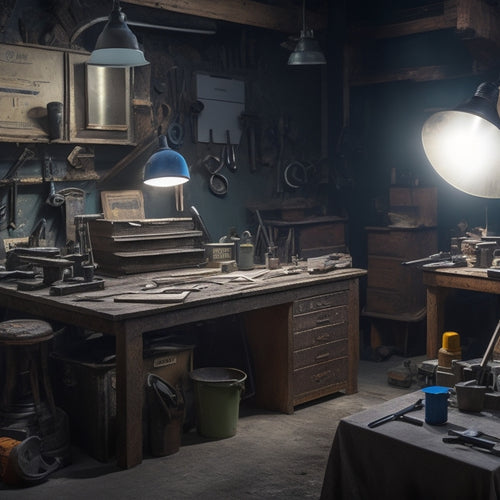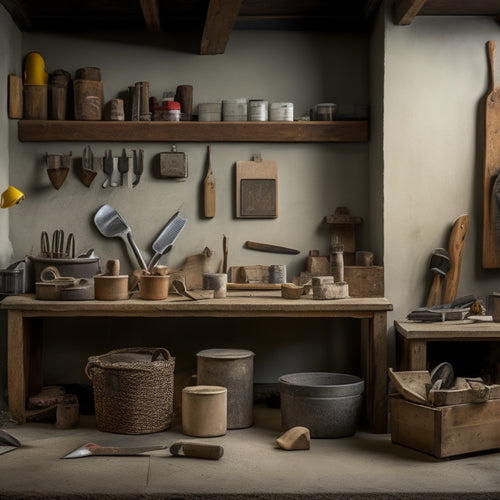
3 Safety Tools for a Hazard-Free Home Renovation
Share
When renovating your home, you'll want to prioritize three essential safety tools to minimize the risk of accidents and fatalities: fall protection gear, respiratory protection equipment, and electrical shock prevention devices. Fall protection gear, such as harnesses and ropes, guarantees you're secure when working at heights. Respiratory protection equipment, like masks that filter out 99.97% of particles as small as 0.3 microns, protects you from airborne contaminants. Additionally, electrical shock prevention devices, including voltage testers and circuit breakers, confirm that power is off before starting work. By incorporating these tools, you'll take a significant step towards a hazard-free renovation, and exploring each further will provide even greater peace of mind.
Key Takeaways
• Use personal fall protection equipment, like harnesses and ropes, when working at heights exceeding 6 feet to prevent serious injury or death.
• Wear respiratory masks that filter out 99.97% of particles as small as 0.3 microns to protect against airborne contaminants.
• Confirm all electrical components are turned off before starting work, and use voltage testers or circuit breakers for circuit safety.
• Designate a spotter to monitor activity and provide assistance, especially when working at heights or with heavy materials.
• Regularly inspect tools and equipment for wear and perform routine maintenance to prevent electrical accidents and other hazards.
Protecting Yourself From Falling
When working at heights during a home renovation, you must make certain you're properly secured to prevent falls, which can result in serious injury or even death. Fall protection is vital, and it's important to understand the risks involved.
Ladder safety is a significant aspect of fall protection. You should always maintain three points of contact with the ladder, whether it's two hands and one foot or two feet and one hand. Confirm the ladder is on a firm, level surface, and never lean over the side rails to reach for something.
You should also consider using personal fall protection equipment, such as harnesses and ropes, especially when working at heights exceeding 6 feet. Always inspect your equipment before use, and verify it's properly fitted and secured.
Additionally, designate a spotter to monitor your activity and provide assistance if needed. Don't take fall protection lightly - it's a matter of life and death.
Preventing Respiratory Hazards
As you move from securing your physical presence on the job site to ensuring a safe working environment, you'll need to address another vital aspect of home renovation safety: protecting yourself from airborne contaminants that can cause respiratory hazards.
Respiratory hazards are a major concern during home renovation, as they can cause long-term health problems or even death. To mitigate these risks, it's important to use respiratory masks that filter out 99.97% of particles as small as 0.3 microns. Make sure to choose a mask that fits snugly on your face and has a filter designed for the specific contaminants you're working with.
In addition to respiratory masks, a well-functioning ventilation system is fundamental for removing airborne contaminants from the work area. This can be as simple as opening windows and using fans to circulate the air or investing in a more advanced ventilation system that can handle larger renovation projects.
Safeguarding Against Electrical Shock
You must take precautions to safeguard against electrical shock, which can be fatal, by confirming all electrical components, including outlets, switches, and wiring, are turned off before starting any renovation work.
This is essential to prevent electrical shock, which can occur when you touch live wires or electrical components. To confirm circuit safety, always verify that the power is off using a voltage tester or circuit breaker.
Additionally, you should:
-
Regularly inspect your tools and equipment for signs of wear and damage, and perform routine tool maintenance to prevent electrical faults.
-
Use ground fault circuit interrupters (GFCIs) and arc fault circuit interrupters (AFCIs) to provide an extra layer of protection against electrical shock.
-
Keep your workspace clean and dry to prevent electrical accidents, and avoid overloading outlets with too many devices.
Frequently Asked Questions
What Kinds of Personal Protective Equipment Are Essential for Home Renovation?
When you're tackling a home renovation, you're exposing yourself to potential hazards. To minimize risks, you'll need essential personal protective equipment.
You should invest in a hard hat to safeguard your head from falling objects and debris.
Additionally, safety goggles will protect your eyes from dust, chemicals, and flying particles.
Don't overlook these critical items – they're your first line of defense against serious injuries.
How Can I Minimize the Risk of Injury From Heavy Objects and Tools?
When handling heavy objects and tools, you'll want to prioritize proper lifting techniques to avoid strains and sprains.
Start by bending at the knees, keeping the object close to your body, and lifting with your legs rather than your back.
Additionally, maintain a clean and organized workspace by designating specific areas for tool storage, ensuring they're easily accessible and reducing the risk of tripping or slipping.
Are There Any Specific Safety Considerations for DIY Projects at Night?
When working on DIY projects at night, you'll want to prioritize night visibility to avoid accidents.
Make certain you have adequate lighting solutions in place, such as LED work lights or headlamps, to illuminate your workspace. This will help you see obstacles and potential hazards, reducing the risk of tripping or misusing tools.
Also, consider wearing reflective clothing or vests to increase your visibility, especially if you're working in areas with limited lighting.
What Measures Can I Take to Prevent Damage to Neighboring Properties?
When undertaking a DIY project, you must prioritize neighborly consideration.
To prevent damage to neighboring properties, you'll want to establish open communication with your neighbors, discussing your project scope and timeline.
Clearly define property boundaries by marking them with flags or cones, ensuring you stay within your own property lines.
This proactive approach will mitigate potential issues, fostering a harmonious renovation experience for all parties involved.
Can I Reuse Safety Gear From Previous Projects or Should I Buy New?
You're probably thinking, 'Why waste money on new safety gear when you've got perfectly good stuff from previous projects?'
But here's the thing: you wouldn't reuse a parachute after a few jumps, would you? Safety gear has a lifespan, and you need to respect it.
Instead of risking your life, invest in new gear or properly maintain the old ones. Regularly inspect and clean your gear, store them properly, and replace worn-out parts.
Don't gamble with your safety – it's not worth the cost.
Conclusion
By investing in these three essential safety tools, you'll greatly minimize the risk of accidents during your home renovation project.
Consider the case of Sarah, who suffered a devastating fall from a ladder while painting her ceiling without proper safety gear.
Had she used a ladder stabilizer, she might've avoided the broken wrist and costly medical bills.
Don't take the same risk – prioritize your safety and invest in these must-have tools today.
Related Posts
-

What to Inspect When Buying Used Renovation Tools
When buying used renovation tools, you need to scrutinize every detail to avoid costly mistakes. Inspect for rust and...
-

3 Best DIY Home Renovation Timelines for Success
As you tackle your DIY home renovation project, create a solid timeline by breaking it down into three phases. First,...
-

3 Beginner-Friendly Tools for Plaster Renovation Success
You'll be glad to know that the three essential tools you need for a successful plaster renovation are the same ones ...


